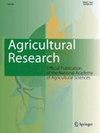Climate-Driven Dynamics of Grain Production in Russia in XX–XXI Centuries: A Review of Statistical Models in Historical Studies
Abstract
Multiple changes in centralized agricultural policies over the past 100 years have influenced crop production in Russia. The differential contributions of political and climatic factors in the performance of Russian agriculture have been widely examined in many historical and economic contexts. Besides traditional descriptive analysis statistical models proved their usefulness due to the quantitation of the role of both factors. We review the results of the statistical models of climate-driven dynamics of grain production in Russia in different historical periods. The modeling approach also proves its actuality today when Russia surprisingly emerges as a major net exporter of grain. Many experts attribute this success to a warmer climate, extending the growing season. Yet climate-yield modes are unable to fully explain this unprecedented yield increase with climate change alone. We propose that projecting climate change’s impact on yields under climate change in countries with transition economies needs to account more for the political factor in grain production.

 求助内容:
求助内容: 应助结果提醒方式:
应助结果提醒方式:


